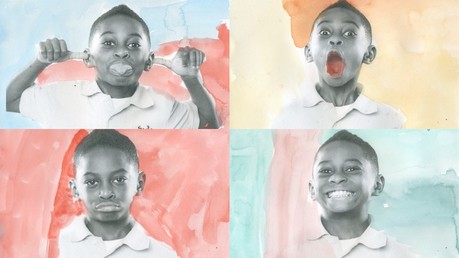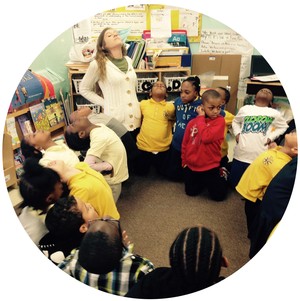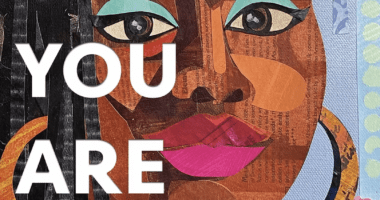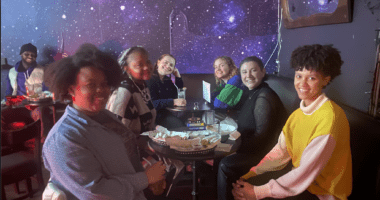It recently occurred to me that there is a striking similarity between construction work and Teaching Artistry. I am referring to something much deeper than the common grounds of hard labor and messy materials. Both depend indispensably upon scaffolding, defined by Wikipedia as “a temporary structure used to support a work crew and materials to aid in the construction, maintenance and repair of buildings, bridges and all other man-made structures”. Living in the city that we do, all of us encounter scaffolding quite regularly while walking the streets, but I had never stopped to consider the literal and figurative impact it has upon supporting the building of better futures.
In its translation to Teaching Artistry, I have witnessed the vital importance of scaffolding as my mentors prepared our students for their culminating events throughout their entire residency. There were essentially two culminating events, the first taking place about halfway through the residency where the students performed their individual and class poems in the auditorium. The very final event consisted of an artwork gallery walk and a video showing of the students’ portrait photos, corresponding audio clips, pieces of art and poems spanning the entirety of the residency.
During my first week, students were finishing up a community collage based on discussions of setting deriving from a neighborhood walk they had taken. The following week, as the collage came to be completed, they composed stanzas in table groups. This was an introduction to the next week’s session, where they combined all of the stanzas to form a cohesive class poem. After developing familiarity with certain poetic techniques, they then moved on to writing individual poems the week after that.
Over the next month, my mentors continued to mindfully build the students’ skills and also create a sense of classroom community. The next transition was into a group circle activity about tree rings, fostering a sense of comfort and trust amongst the students. Then, students sat and rehearsed their individual poems within their table groups, also coming up with a gesture to pair with their performance. Next, there was a “group rehearsal,” where each student came up and presented their poems one by one to their entire class, arranged by table group. Finally, the last week in January was their poetic performance, held in the auditorium in front of the classes from their entire grade. The week after the performance, a lesson was devoted to a reflection of all of the previous lessons and about the event itself.
The next couple of months were structured in a similar fashion. Students were introduced to watercolor painting, and then had their portraits taken by a professional photographer, U-Shin. Then, they painted their portrait photos with the watercolors that they felt expressed the emotions captured in their expressions. Next, we discussed writing captions for their developing pieces of art, again connected to the emotions in the colorful photos. Following this was a mini-gallery showing held just within the classroom, where students went to other tables to view their peers’ works and compose “opinion pieces” about them. All of this led to the final gallery showing, again held in the auditorium for all of the classes in their grade, where the portrait artwork was laid out and the other pieces from the semester showcased in the video.

By slowly and steadily learning skills, using each new lesson to reinforce the past as well as build towards the future, major goals were able to be accomplished that had seemed overwhelming at the beginning. My mentors were very attentive to the fact that some students may not have had exposure to certain artistic or poetic practices, always defining vocabulary terms and modeling the activities before sending students off to complete the tasks on their own. Defining the expectations at the start of the semester and clearly communicating them throughout was another way in which my mentors Katie Issel Pitre and Max Allbee managed to establish the foundation that made these achievements possible.
In viewing this gradual progression, I was very much reminded of the way that the TATIP program itself was structured. Initially, we had professional development seminars every Saturday that familiarized the trainees with what we would encounter while working in the Teaching Artist field. Renee and Patti always included activities that were practically useful, such as model lessons that trainees engaged with as “students” so that we could eventually incorporate them into working with our own future classrooms. While the seminars began with more theoretical grounding, during the last few we were paired with another trainee to practice co-teaching in a hands-on way. We were first asked to write a lesson plan, sharing portions of these in front of the entire group at the following seminar. After performing this task, we moved on to composing an entire teaching residency path with our partners. All of these exercises ultimately prepared us to begin shadowing our mentors during our own internship residencies. Towards the end of our internships, we were fully enabled to write our own lesson plans once again, this time actually conducting them with the students in our classrooms.

In a society that places such emphasis on the delivery of a finished product, it can be easy to forget the importance of the processes that make it all possible. When I first read the definition of scaffolding that I provided at the start of this blog, I was so taken aback by the word “temporary.” Reflecting on this entire experience, TATIP was seven months that seemed to fly by, only a handful of the months I hope to enjoy during my Teaching Artist career. Similarly, the months teachers share with their students are fleeting, ending each spring with graduations and goodbyes. Yet it is within the small moments, in the baby steps towards bigger things, that the real work begins and ends. Practice doesn’t make perfect: practice is perfect. Here, we as Teaching Artists have the space to pass on the tools to build a better world.
-Megan Skelly, Writer, TATIP Trainee
Interested in TATIP? Find out more about our 2015-16 Program!
See more of our 2014-15 Graduates in the 2015 TATIP Anthology!



